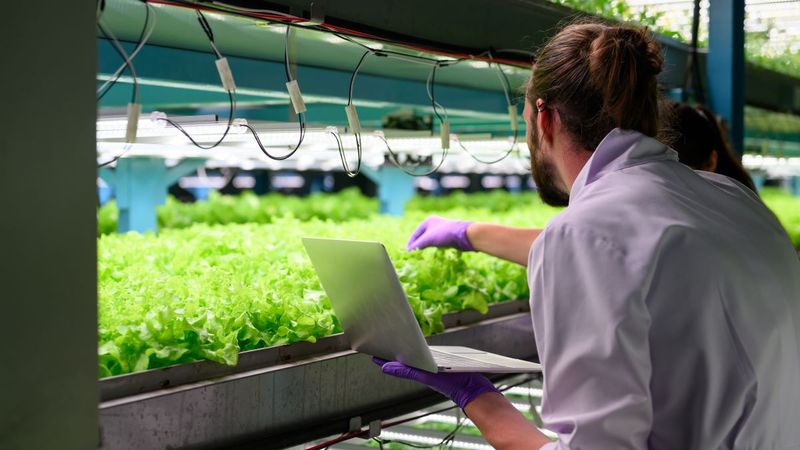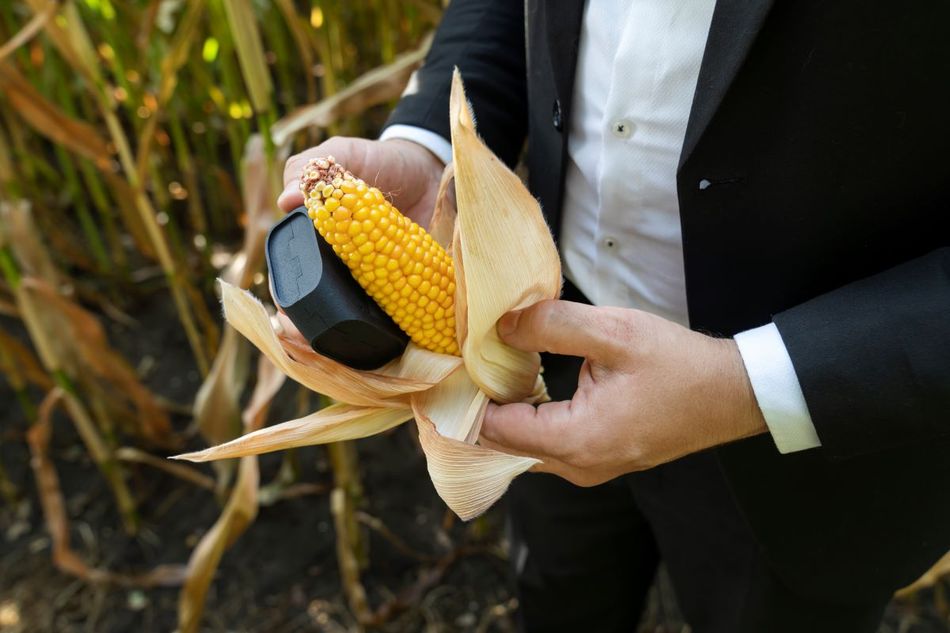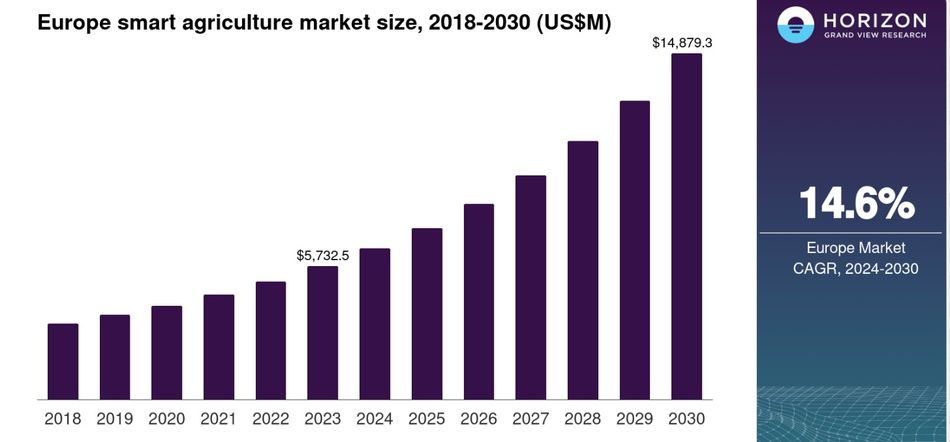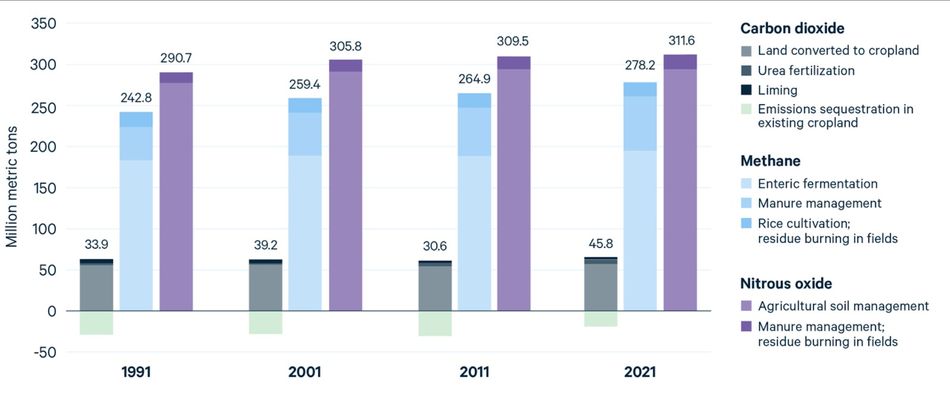Integrated Photonics for AgriFood: A Roadmap for Sustainable Transformation
Agriculture must feed 10 billion people by 2050 while cutting emissions and waste. Integrated photonics offers a solution with advanced sensors for efficient, high-yield farming.

Global Photonics Engineering ContestThis engineering challenge invites engineers, innovators, and startups to push the boundaries of Photonic Integrated Circuits (PIC) and create applications that address complex engineering challenges and push the boundaries of the industry. Whether you’re in semiconductors, data & telecom, medtech, or agritech, we want to see your breakthrough idea that can harness the power of PICs to change the world.
|
Agriculture is a major source of greenhouse gas emissions and food waste, with about one-third of all food produced globally being lost or wasted each year. Moreover, feeding a global population expected to reach 10 billion by 2050 poses a formidable challenge. To meet this need, we must change how we farm and produce food. These changes should focus on being sustainable while also increasing food production.
The agrifood sector has two main goals: to provide food for a growing population and reduce its environmental impact. Integrated photonics technology shows promise in making agriculture more efficient and sustainable. This technology enables farmers to use small sensors that deliver precise information, helping them make better decisions, use resources wisely, reduce the use of fertilizers and pesticides and improve crop yields.
Let’s explore how integrated photonics can revolutionize the agrifood industry.
Understanding the Challenges of Feeding the World
The global agrifood industry operates vastly. This ecosystem encompasses agriculture ($12 trillion), food retail ($12 trillion), food processing ($4 trillion), and food service ($2.5 trillion). However, this enormous scale also brings inefficiencies. For instance:
Greenhouse Gas Emissions: Livestock accounts for around 14.5% of global emissions, driven by methane and other gases.
Food Waste: An estimated 1.3 billion tons of food is wasted yearly, producing 3.3 billion tons of carbon dioxide.
Resource Depletion: Unsustainable farming practices lead to soil degradation, biodiversity loss, and water scarcity.
Immediate interventions are essential, such as reducing food waste and long-term adoption of sustainable and precision farming methods. Integrated photonics chips with advanced sensing capabilities—can offer actionable insights to farmers and stakeholders, driving this transformation.
Trends in Precision Agriculture
Precision agriculture uses technology, such as sensors, GPS mapping, and data analytics, to optimize resource use, improve efficiency, and enhance crop yields. Three key components drive this approach:
Monitoring Systems: Sensors measure humidity, air pressure, and chemical composition.
Data Modeling and Algorithms: These tools analyze collected data to provide actionable insights.
Actionable Technology: Devices like drones and robots act on the insights to improve farming practices.
Below are the key trends shaping this dynamic field:
1. The Power of Smart Sensors
Smart sensors enable smart agriculture by providing precise, real-time data about crops, soil, and environmental conditions. Similar to wearable health devices that monitor human metrics, these sensors can detect soil moisture, nutrient levels, fruit ripeness, and even early signs of disease.
The global agriculture sensing market is projected to grow, reaching an estimated $2.63 billion by 2026, as farmers adopt these tools to increase yields while reducing environmental impact. Integrated photonics plays a critical role in this growth by enabling the miniaturization of sensors and improving their accuracy and affordability. Integrated Photonics-powered devices, such as Near-infrared (NIR) and Raman spectroscopy sensors, allow detailed chemical and physical analysis directly in the field.
Benefits of Smart Sensing
Farmers can monitor plant health, hydration, and nutrient levels, reducing fertilizer and water waste. Integrated photonic chips make these measurements faster and more precise by enabling sensors to perform complex optical analyses in real-time.
Smart devices can perform tasks like fruit picking and tree pruning, addressing labor shortages and ensuring optimal yields. Integrated photonics-based imaging technologies, such as LiDAR, enhance the precision of these automated systems.
Technologies like LiDAR and NIR sensors support real-time analysis of crop health and soil conditions.
2. Automation in Harvesting and Crop Management
Labor shortages and the aging agricultural workforce are driving innovation in automation. Technologies like robotic fruit pickers and automated pruning systems are becoming indispensable, especially in countries where experienced growers are retiring without successors.
Integrated photonics powers the advanced sensors in these systems, allowing them to process large volumes of data quickly and accurately, ensuring precision in harvesting. Automation enhances productivity and helps preserve valuable farming expertise through data-driven processes.
3. Optimized Use of Fertilizers and Pesticides
The high costs and environmental impacts of fertilizers and pesticides are strong drivers for farmers to move toward precision farming. Integrated photonics enables smart diagnostics, allowing farmers to selectively apply treatments, targeting only infected plants or specific areas of need, taking out large amounts of guesswork and unnecessary labor and cost. This localized approach reduces costs, minimizes environmental harm, and improves soil health and biodiversity, supporting sustainable agriculture.
4. Livestock Farming and Emission Reduction
Livestock farming accounts for approximately 14.5% of global greenhouse gas emissions, making emission reduction a critical focus. Integrated photonics enhances gas monitoring systems by making them more sensitive and compact, enabling farmers to detect harmful emissions more accurately.
The figure below uses data from the EPA Greenhouse Gas Inventory Data Explorer to summarize sources of agricultural greenhouse gas emissions over the past 30 years (in carbon dioxide equivalents).
Recent studies show that using these technologies can cut emissions by up to 50%, improving sustainability while maintaining productivity.
Photonic Integrated Circuits (PICs), such as those used in real-time gas sensors from Spectrik, play an important role by enabling the precise detection of harmful gases, including methane and ammonia. These compact and efficient sensors provide accurate, continuous monitoring, helping farmers take immediate action to reduce emissions and comply with environmental regulations.
Precision agriculture continues to evolve, integrating smart diagnostics, automation, and targeted interventions to address the challenges of modern farming. With advancements in PIC technology, these innovations become even more powerful, offering enhanced accuracy, scalability, and cost-effectiveness. By leveraging these innovations, farmers can achieve a balance between economic viability, food security, and environmental stewardship.
Optimizing Output in Food Processing and Retail
The food processing industry is a vital part of the agrifood sector, and it is projected to grow from $163.79 Billion in 2024 to $400.43 Billion by 2030. As this industry grows, the need for efficiency and sustainability becomes increasingly important. Smart technologies can play a crucial role in optimizing food processing and retail operations.
Importance of Real-Time Monitoring
Integrated photonics enables real-time feedback on food composition, improving process control and reducing losses. Portable devices equipped with photonic technology allow producers to test variables such as temperature and pH directly on-site, eliminating delays associated with laboratory testing.
By integrating real-time monitoring into production processes, food producers can gain immediate insights into their products. This shift allows for quicker adjustments and consistently meets quality standards.
Vegetables and fruit in supermarkets are important reputation factors. By measuring real time conditions like ripeness, they are able to give their customers the best products and avoid waste at the same time.
Ensuring Food Safety and Quality
Advanced diagnostics preserve nutrients, maintain flavor, and ensure compliance with food safety regulations. These tools also help producers adapt processes to variations in raw materials, optimizing output and reducing waste.
Detecting Problems Early to Reduce Waste
Real-time feedback on food composition enables earlier detection of potential issues that could lead to waste or quality problems. With precise monitoring, producers can address issues promptly, preventing losses and improving product quality. Early detection can reduce costs and minimize waste, which benefits both the environment and the bottom line.
Integrated Photonics as a Solution
Integrated photonics technology offers a great solution for real-time remote sensing in food processing. It helps farmers and food producers monitor crop and food composition more accurately using small, powerful chips called photonic integrated circuits (PICs). This helps them make better decisions at every stage of the supply chain.
As this technology develops, it creates new opportunities in the agrifood industry. The ability to make smaller sensors that use less power means that these devices can be used in the field or at production sites. This helps workers get the information they need right where it is needed.
Applications of Integrated Photonics in AgriFood
Integrated photonics, with its compact design and low power consumption, offers vast potential for the agrifood sector:
Sensor Fusion: Combining multiple sensing technologies into portable devices enables comprehensive analysis. For instance, a single device could measure sugar and moisture content, defects, and firmness of a tomato.
Lidar Technology: This 3D mapping tool helps farmers analyze landscapes, water flow, and machinery locations, and support picking and pruning.
NIR and Raman Spectroscopy: These techniques analyze chemical compositions, from soil nutrients to milk content, enabling precise management of farming inputs.
- Biochips: These devices detect specific biochemical components like bacteria or plant diseases (e.g e-coli or lysteria), supporting targeted interventions.
 Integrated photonics enable a new generation of innovative agriculture technologies. Image credit: Brainport.
Integrated photonics enable a new generation of innovative agriculture technologies. Image credit: Brainport.

Real-World Impact of Photonic Chip Applications
Several companies are already leveraging integrated photonics in innovative ways:
Ommatidia Lidar: Advanced sensors for high-resolution agricultural mapping.
MantiSpectra: Compact NIR sensors for analyzing soil, milk, and other food products
Spectrik: Spectroscopic sensors for monitoring methane and ammonia emissions in livestock farming.
These innovations show the transformative potential of integrated photonics in improving efficiency, reducing environmental impact, and enhancing food safety.
How Integrated Photonics Works
The versatility of photonic integrated circuits (PICs) lies in their ability to perform diverse functions using a single platform. Key technologies include:
NIRS (Near Infrared Spectroscopy): Uses the NIR and SWIR regions (850-3000 nm) to gather data on chemical compounds. Integrated photonics makes these areas accessible through small, cost-effective detectors on a chip.
Raman Spectroscopy: Uses laser scattering to identify material composition. Integrated solutions make devices smaller and more affordable using powerful lasers and filters.
Photoacoustic Spectroscopy: Detects low concentrations of gases by creating pressure waves through laser-induced heating. It is useful for gases, liquids, and solids.
Laser Speckle Imaging: Measures flow by detecting light intensity fluctuations when particles move under laser illumination. It is useful for real-time monitoring of sap flow.
Lidar: Measures distance and speed using light beams. Integrated into PICs for high-resolution, affordable applications like autonomous vehicles and agriculture.
Terahertz Spectroscopy: Sensitive to water and complex molecules, this technology uses integrated photonics to create small, affordable systems for detecting THz signals.
By combining these technologies with AI and advanced computing, PICs enable real-time, actionable insights that were previously inaccessible.
A Sustainable Vision for the Future
Integrated photonics technology in the agrifood sector represents a significant step toward sustainable and efficient food production. This innovation offers solutions to some of the industry’s most pressing challenges by reducing resource use, minimizing waste, and enhancing yields. Key outcomes include:
Optimized Food Supply Chains: From farm to fork, photonics ensures peak freshness and flavor.
Sustainable Practices: Reduced greenhouse gas emissions and resource conservation.
Enhanced Productivity: Higher yields and improved crop and livestock management.
The whole Agrifood value chain, from production to processing and distribution, need easy-to-use affordable solutions. This means in many cases the combination of sensing, robotics and (AI) software. However, cooperation and development are needed to mature the solutions, which are costly and take time. Small companies cannot always afford that. And the low cost can only be achieved when the volumes are there. This is where pre-competitive development and programs like the PhotonDelta growth fund play a pivotal role.
The PhotonDelta Challenge
PhotonDelta has launched a Global Photonics Engineering Contest, in collaboration with Wevolver, to drive innovation in applications for PICs across sectors such as healthcare, autonomous vehicles, AI, and agriculture. The contest offers a €50,000 prize in services for the winning concept, global exposure at an industry event, and a chance to receive up to €2 million in pre-seed funding.
The event is backed by a €60 million fund from PhotonDelta and industry leaders, including SMART Photonics, LioniX International, Bright Photonics, Epiphany, and PHIX Photonics Assembly. The contest will be officially launched at the PIC Summit 2024 in Eindhoven, Netherlands, on October 15, with submissions open until March 3, 2025, and winners announced on April 2, 2025.
Prize: €50,000 worth of services from the PhotonDelta ecosystem to to make your idea market-ready + a chance to receive up to €2 million in pre-seed funding.
Audience: Open to all engineers, researchers, OEMs, hardware manufacturers, startups/scale-ups, research teams, and students working on innovative PIC applications.
End date: March 3rd 2025




